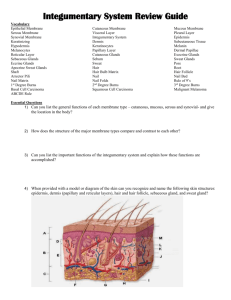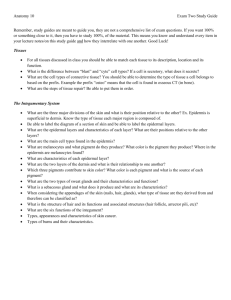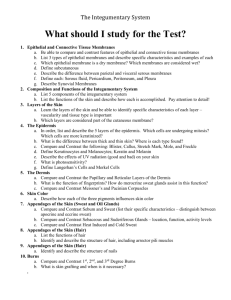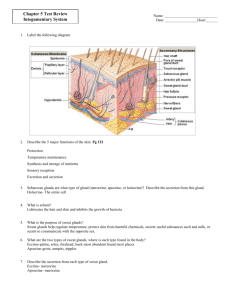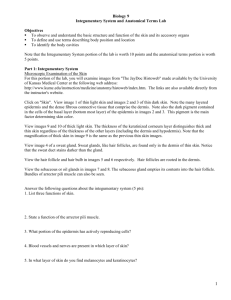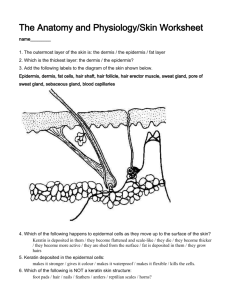Chapter 4 Packet
advertisement
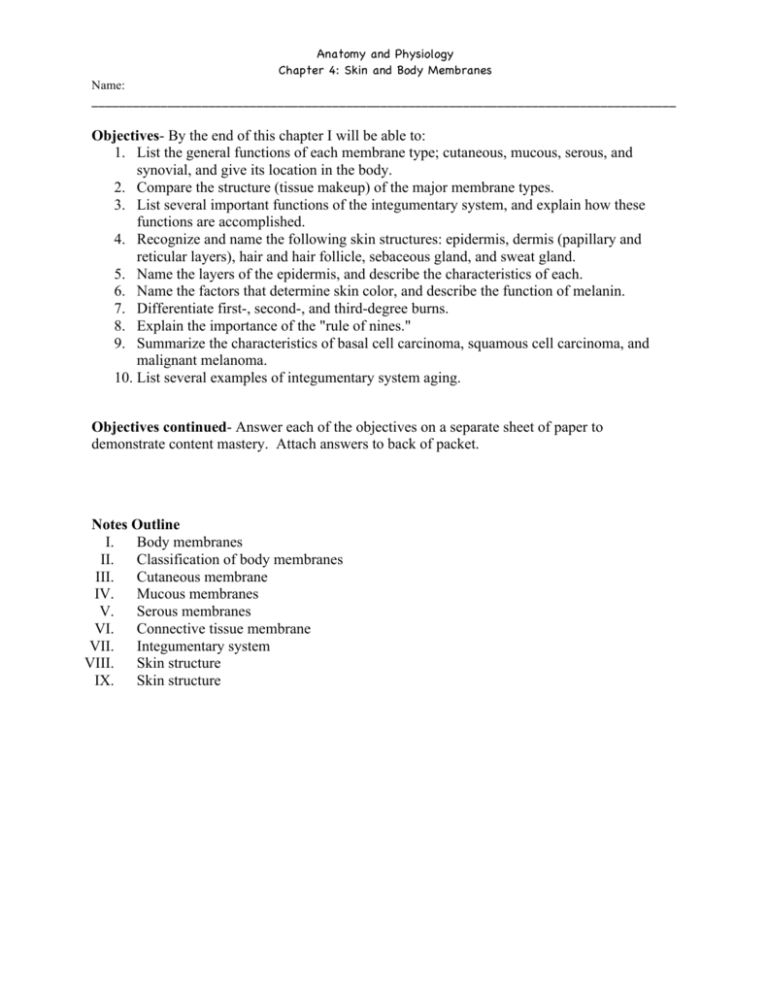
Anatomy and Physiology Chapter 4: Skin and Body Membranes Name: _____________________________________________________________________________________ Objectives- By the end of this chapter I will be able to: 1. List the general functions of each membrane type; cutaneous, mucous, serous, and synovial, and give its location in the body. 2. Compare the structure (tissue makeup) of the major membrane types. 3. List several important functions of the integumentary system, and explain how these functions are accomplished. 4. Recognize and name the following skin structures: epidermis, dermis (papillary and reticular layers), hair and hair follicle, sebaceous gland, and sweat gland. 5. Name the layers of the epidermis, and describe the characteristics of each. 6. Name the factors that determine skin color, and describe the function of melanin. 7. Differentiate first-, second-, and third-degree burns. 8. Explain the importance of the "rule of nines." 9. Summarize the characteristics of basal cell carcinoma, squamous cell carcinoma, and malignant melanoma. 10. List several examples of integumentary system aging. Objectives continued- Answer each of the objectives on a separate sheet of paper to demonstrate content mastery. Attach answers to back of packet. Notes Outline I. Body membranes II. Classification of body membranes III. Cutaneous membrane IV. Mucous membranes V. Serous membranes VI. Connective tissue membrane VII. Integumentary system VIII. Skin structure IX. Skin structure 1. Complete the following table relating to body membranes Membrane Tissue Common Functions type locations Mucous Serous Cutaneous Synovial 2. Four diagrams are shown below. Select different colors for the membranes listed below, and use them to color the coding circles and the corresponding structures o Cutaneous membrane o Mucosae o Visceral pleura (serosa) o Parietal pleura (serosa) o Visceral pericardium (serosa) o Parietal pericardium (serosa) o Synovial membrane 3. The skin protects the body by providing three types of barriers. Classify each of the protective factors below using: chemical, mechanical, biological A. Langerhans' cells and macrophages __________ B. Intact epidermis ___________________ C. Bactericidal secretions ______________ D. Keratin __________________________ E. Melanin __________________________ F. Acid mantle _______________________ 4. In what way does a sunburn impair the body's ability to defend itself (mild burn) 5. Explain the role of sweat glands in maintaining body temperature homeostasis. In your explanation, indicate how their activity is regulated. 6. A longitudinal section of the skin is below. Label the skin structures and areas. Select different colors for the structures below and color coding circles and the corresponding structures on the figure o Arrector pili muscle o Adipose tissue o Hair follicle o Nerve fibers o Sweat (sudoriderous gland) o Sebaceous gland 7. The more superficial cells of the epidermis become less viable and ultimately die. What two factors account for this natural demise of the epidermal cells? 8. Enter the appropriate responses that apply to the following: A. Translucent cells, contain keratin ______________________________ B. Strata containing all or mostly dead cells ______________________________ C. Dermis layer responsible for fingerprints ______________________________ D. Vascular region ___________________ E. Epidermal region involved in rapid cell division; most inferior epidermal layer _____________________________ F. Scale like cells full of keratin that constantly flake off _____________________________ G. Site of elastic and collagen fibers _____________________________ H. Site of melanin formation _____________________________ I. Major skin area from which the derivatives (hair, nails) arise ____________________________ J. Epidermal layer containing the oldest cells __________________________ K. When tanned becomes leather ______________________________ 9. For each true statement write T. For each false statement correct the italicized word (s) A. A saltwater solution is secreted by sebaceous glands _____________________ B. The most abundant protein in dead epidermal structures such as hair and nails is melanin _____________________________ C. Sebum is an oily mixture of lipids, cholesterol, and cell fragments _________________________________ D. The externally observable part of a hair is called the root ______________________ E. The epidermis provides mechanical strength to the skin ____________________ 10. Using the following terms, insert appropriate term in answer blanks. Arrector pili, hair, sebaceous gland, sweat gland (eccrine), cutaneous receptors, hair follicle, sweat gland (apocrine) A. A blackhead is an accumulation of oily material produced by __________________ B. Tiny muscles attached to hair follicles that pull the hair upright during fright or cold are _____________________________ C. The most numerous variety of perspiration gland is the ________________ D. A sheath formed of both epithelial and connective tissue is the _________________ E. A less numerous variety of perspiration gland is the _________________. Its secretion contains proteins and other substances that favor bacterial growth F. __________________ is found everywhere on the body except the palms of the hands, soles of feet, and lips, and it primarily consists of dead keratinized cells G. ___________________ are specialized nerve endings that respond to temperature and touch, for example H. ____________________ Become more active at puberty I. Part of the heat-liberating apparatus of the body is the _________________________ J. Secretin contain bacteria-killing substance __________________________ 11. Overwhelming infection is one of the most important causes of death in burn patients. What is the other major problem they face, and what are its possible consequences? 12. Using 1st degree, 2nd degree, or 3rd degree burns; write the appropriate choice for each blank below A. Full-thickness burn; epidermal and dermal layers destroyed _____ B. Blisters form _____ C. Epidermal damage, redness, and some pain (brief) ____ D. Epidermal and some dermal damage; pain; regeneration possible _______ E. Regeneration is impossible; requires grafting _____ F. Pain is absent because nerve endings in area are destroyed _____ 16. Would you expect to find the highest rate of skin cancer among the Blacks of tropical Africa, scientists in the Arctic, Norwegians in the Southern US, or Blacks in the US. Explain your choice. 17. After studying the skin in anatomy class, Toby grabbed the large "love handle" at his waist and said, "I have too thick a hypodermis, but that's ok because this layer performs some valuable functions!" What are those functions? 13. Fill in the type of skin cancer that matches each of the following: A. Epithelial cells, not in contact with the basement membrane, develop lesions; metastasize___________________ B. Cells of the lowest level of the epidermis invade the dermis and hypodermis; exposed areas develop ulcer; slow to metastasize _______________________ C. Rare but often deadly cancer of pigment producing cells ____________________ 14. Patients in hospital beds are rotated every 2 hours to prevent bedsores. Exactly why is this effective? 15. Eric and his wife are of northern European descent. When his daughter was born, her skin was purple and covered with a cream-cheese-like substance. Shortly after birth she turned pink. Explain his observations 18. In cases of a ruptured appendix, what serous membrane is likely to become infected? Why can this be life threatening? Define Chapter 4 Vocabulary 1. Epithelial membrane 2. Cutaneous membrane 3. Mucous membrane 4. Serous membrane 5. Serous fluid 6. Peritoneum 7. Pleura 8. Pericardium 9. Synovial membranes 10. Skin 11. Integument 12. Keratin 13. Epidermis 14. Dermis 15. Subcutaneous tissue (hypodermis) 16. Keratinocytes 17. Melanin 18. Melanocytes 19. Herpes simplex 20. Papillary layer 21. Dermal papillae 22. Reticular layer 23. Decubitus ulcers 24. Cyanosis 25. Skin appendages 26. Exocrine glands 27. Sebaceous glands 28. Sebum 29. Seborrhea 30. Sweat glands 31. Sudoriferous glands 32. Eccrine glands 33. Sweat 34. Apocrine glands 35. Hairs 36. Matrix 37. Arrector pili 38. Nail 39. Cold sores 40. Contact dermatitis 41. Impetigo 42. Psoriasis 43. Burn 44. Rule of nines 45. First-degree burn 46. Second-degree burn 47. Partial-thickness burns 48. Third-degree burns 49. Full-thickness burns 50. ABCD rule
